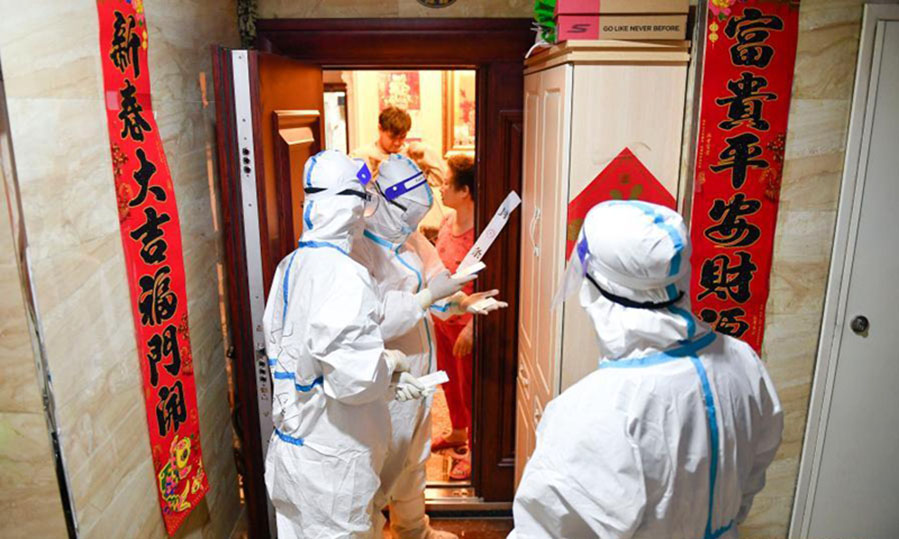


Medical workers check COVID-19 screening information at a residential area in Dongchang District of Tonghua, northeast China's Jilin Province, Jan. 25, 2021. Tonghua on Monday launched the third round of citywide nucleic acid testing. (Xinhua/Xu Chang)
New local coronavirus infections in Chinese mainland could fall to zero over the next two week thanks to effective and timely epidemic prevention and control measures that includes encouraging people not to travel during the upcoming Spring Festival holiday, said a Chinese researcher.
However, the researcher warned the country need to be alert for possible new sporadic cases due to the flow of people and materials especially from overseas.
The prediction comes after the current COVID-19-affected areas in China are seeing a downward trend in the number of new confirmed cases and asymptomatic patients.
Shijiazhuang, North China’s Hebei Province on Friday restarted normal life accompanied by normalized anti-epidemic work as public transportation resumed and supermarkets reopened. Local media said the city was bustling again with street traffic and people shopping for Spring Festival.
The city confirmed one case on Friday, which was the only case recorded in the province on the day. The case, a close contact with a previously confirmed case, had tested negative three times before testing positive on Friday.
In Hebei, the number of the new infections has fallen to single digits for five consecutive days, and no asymptomatic carriers have been detected for four consecutive days.
According to the provincial health authority, two medium-risk areas in Shijiazhuang were declared low risk on Saturday.
China now has 10 high-risk areas and 63 medium-risk areas.
Changchun, Northeast China’s Jilin Province has lowered its main urban area to low risk and all closed-off areas have been opened, the provincial government said on its WeChat on Friday.
Jilin reported five new cases and two silent carriers on Friday, which are found in the cities of Changchun and Tonghua.
Dalian, Northeast China’s Liaoning Province said on Saturday it had removed its request that people leaving the city provide a negative nucleic acid test certificate taken no later than three days before departure. The city is still encouraging residents not to leave unless necessary.
The city on Saturday reopened all communities which had been closed for epidemic prevention and control.
The last confirmed patient in Dalian was discharged from hospital on Thursday, marking a phased victory in fighting the recent outbreak that included 51 confirmed cases and 32 silent carriers.
Among the current epidemic affected provinces, Heilongjiang Province in Northeast China, had the largest number of new confirmed cases and asymptomatic infections. On Friday, there were 27 new local confirmed cases and six new asymptomatic infected people in the province’s cities of Suihua and Harbin.
With the withdrawing tide of new cases, some cities in Heilongjiang have adjusted their risk levels.
Harbin’s government elevated the risk level along Lanhe street in Hulan district to high-risk on Friday. The city also lowered several local areas to low risk on Friday.
Daqing city reopened theaters, inns and gyms on Friday but at no more than 50 percent occupancy.
Liang Manchun, an associate research fellow at the Institute for Public Safety Research of Tsinghua University, who has been closely following the pandemic, told the Global Times on Saturday that according to his team's research model, the number of new local cases in Heilongjiang could drop to zero in two weeks, after some 1,200 confirmed and asymptomatic cases were reported during this latest outbreak nationwide. The province has reported 499 confirmed cases and 538 asymptomatic patients during the outbreak on Friday.
Liang said local outbreaks across situation in the mainland had reached an inflection point seven to 10 days ago and will continue to ebb.
He predicts that new local cases in Chinese mainland are likely fall to zero in two weeks.
The strict and timely national anti-epidemic work, plus calls for people not to travel during the upcoming Spring Festival holiday will be very effective in fighting the epidemic, Liang noted.
He also warned of the possibility of sporadic cases could remerge in areas given the risk posed by imported materials and the millions of people who still choose to travel during the holiday.

 Award-winning photos show poverty reduction achievements in NE China's Jilin province
Award-winning photos show poverty reduction achievements in NE China's Jilin province People dance to greet advent of New Year in Ameiqituo Town, Guizhou
People dance to greet advent of New Year in Ameiqituo Town, Guizhou Fire brigade in Shanghai holds group wedding
Fire brigade in Shanghai holds group wedding Tourists enjoy ice sculptures in Datan Town, north China
Tourists enjoy ice sculptures in Datan Town, north China Sunset scenery of Dayan Pagoda in Xi'an
Sunset scenery of Dayan Pagoda in Xi'an Tourists have fun at scenic spot in Nanlong Town, NW China
Tourists have fun at scenic spot in Nanlong Town, NW China Harbin attracts tourists by making best use of ice in winter
Harbin attracts tourists by making best use of ice in winter In pics: FIS Alpine Ski Women's World Cup Slalom
In pics: FIS Alpine Ski Women's World Cup Slalom Black-necked cranes rest at reservoir in Lhunzhub County, Lhasa
Black-necked cranes rest at reservoir in Lhunzhub County, Lhasa China's FAST telescope will be available to foreign scientists in April
China's FAST telescope will be available to foreign scientists in April